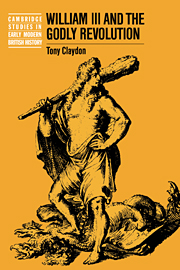Book contents
- Frontmatter
- Contents
- List of illustrations
- Acknowledgements
- List of abbreviations
- Notes on style
- Introduction
- 1 Courtly reformation and the revolution of 1688–1689
- 2 The resources for royal propaganda
- 3 The propagation of courtly reformation
- 4 Courtly reformation, the war, and the English nation
- 5 Courtly reformation and the politics of party
- 6 Courtly reformation and country politics
- Conclusion
- Bibliography
- Index
- Cambridge Studies in Early Modern British History
1 - Courtly reformation and the revolution of 1688–1689
Published online by Cambridge University Press: 09 October 2009
- Frontmatter
- Contents
- List of illustrations
- Acknowledgements
- List of abbreviations
- Notes on style
- Introduction
- 1 Courtly reformation and the revolution of 1688–1689
- 2 The resources for royal propaganda
- 3 The propagation of courtly reformation
- 4 Courtly reformation, the war, and the English nation
- 5 Courtly reformation and the politics of party
- 6 Courtly reformation and country politics
- Conclusion
- Bibliography
- Index
- Cambridge Studies in Early Modern British History
Summary
WILLIAM'S FIRST STRATEGY: THE DECLARATION OF REASONS
When William III, prince of Orange, landed at Torbay on 5 November 1688, the opening shot in his propaganda war had already been fired. A month earlier the prince had issued a manifesto, his Declaration of reasons for appearing in arms in the kingdom of England, which, as its title suggested, offered a vindication for his bringing a military force across the Channel.
This manifesto was crucial for William during his English expedition. It formed the centrepiece of his entire publicity campaign, and was promoted with an extraordinary care and zeal by his supporters. The importance attached to the document within the Stadholder's circle was evident from the moment William had ordered its preparation. It had, for instance, taken weeks to write. Its author, Gaspar Fagel – the Grand Pensionary of Holland and a seasoned producer of Orange publicity – had completed the work only after an exhaustive process of consultation and redrafting. The manifesto had not emerged until the Pensionary had sought advice about the state of opinion in England, until he had held extensive discussions to decide which were the best arguments to deploy, or until experienced pamphleteers had edited and sharpened his prose. Similar care was shown in the distribution of the manifesto. Once the work was finished, it was broadcast through a sophisticated system of publicity which saturated England with the document.
- Type
- Chapter
- Information
- William III and the Godly Revolution , pp. 24 - 63Publisher: Cambridge University PressPrint publication year: 1996



